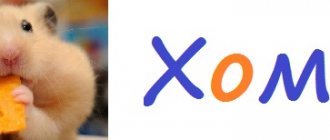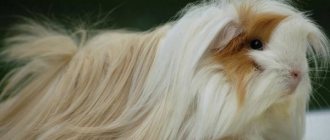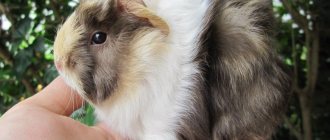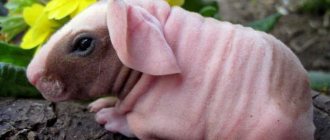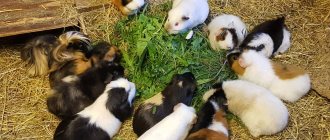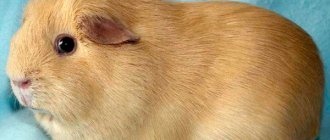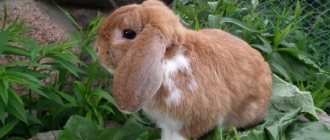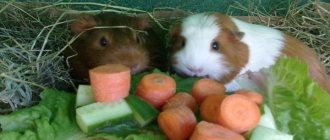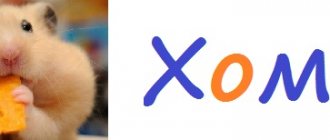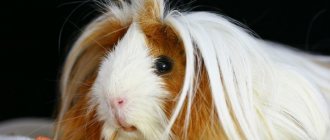Teddy the guinea pig has fluffy fur that makes him look like the famous teddy bear. Thanks to this, the animal received the appropriate name. Teddies are popular as pets due to their peaceful and friendly nature. Information about the characteristics of the breed will help you prepare for possible difficulties in care and maintenance.
History of the breed
These cute animals come from Canada, where they appeared in 1960. Surprisingly, breeders did not specifically breed this breed.
It all turned out completely by accident when, as a result of a genetic mutation, very cute and beautiful animals appeared. This appearance did not leave the breeders indifferent, and they decided to continue breeding this breed.
Regarding the name, everything is very clear here, they are very similar to teddy bears. The breed appeared in our country not so long ago, but in this short period of time it has become very popular and has gained popularity.
Varieties
This breed has several varieties, the main differences of which are the different structure and length of the fur.
So, let's look at the varieties:
- American. Has short fur of medium hardness. They have small ears with drooping tips and are almost bald. The fur on the muzzle is much shorter than on the body.
- Swiss. These are the owners of long fur, which reaches a length of 6 cm. Very hard hairs that even break under mechanical stress.
- Long-haired. This breed was bred by Russian breeders. It is also called Moscow Texel. These are the owners of luxurious wavy fur, the length of which reaches 15 cm. These cute little animals have one feature: they have funny bangs.
Longhair
Shaggy breeds have thick, long fur and are in great demand among lovers of fluffy decorative rodents. They were bred artificially and subjected to strict selective selection.
Breeds whose standard officially includes a pure white color include the Peruvian (Angora) and Abyssinian guinea pig, Merino, Sheltie, Coronet, Texel and alpaca.
Abyssinian
This is the most interesting and most recognizable breed. The Abyssinian guinea pig has one very striking distinctive feature that immediately sets it apart from other varieties.
The Abyssinian coat must have so-called rosettes. They are a kind of funnels and appeared as a result of a genetic mutation.
Each Abyssinian guinea pig has about 6-10 rosettes on its body. They are located throughout the body and are absent only on the head and belly of the animal. Occasionally, the Abyssinian guinea pig has so-called “double rosettes.”
Their maximum number can reach 30 pieces. The animal's long fur can be painted in almost any color, including white.
Alpaca
Alpaca guinea pigs are covered with long, curly hair, the structure of which is more reminiscent of sheep's fleece. It grows from the tail to the head and forms a pair of rosettes on the rump and one on the crown. Representatives of the alpaca breed have coarser hair on their faces.
The color of the animals can be almost any color, including white. Occasionally among alpaca guinea pigs there are two- or three-colored individuals.
Coronet
The Coronet guinea pig has very long hair that flows down the sides and does not cover the face. There is a single rosette on the animal's head.
The coronet guinea pig comes in a variety of colors. It can be either monochromatic or combined. It is noteworthy that the white coronet is not very popular among breeders. It is believed that outwardly it loses to its brighter brothers.
Texel
The Texel cavy is covered with curly hair, the length of which reaches 15 cm. It grows from the head to the back of the body and cascades down the back.
The Texel guinea pig can have almost any color. Among the representatives of the breed there are even white individuals.
Merino
The breed was created by crossing a Coronet and a Texel. It has a crown-shaped rosette on its head and long, wavy fur that is white, gray or other colors.
Sheltie
The Sheltie guinea pig has long hair that does not flow along the sides, but simply falls back. More dense hair grows on the animal’s head, creating a kind of mane.
The Sheltie can have almost any color. But the white representative of this breed attracts less attention than his colored counterparts.
Peruvian
The Peruvian pig is also called the Angora pig. She has an aristocratic appearance and beautiful fur. There are rosettes on the nose and sacrum. The animal's muzzle is covered with long bangs. The Peruvian pig, or angora, weighs up to 1.5 kg and lives up to 6 years. It is painted in almost any color, including white.
Most often, Peruvian guinea pigs have silver-gray fur. Solid white color is extremely rare in the breed. Therefore, such caves are highly valued by breeders.
The long, soft coat of Angora Cavies grows straight forward. She needs careful care. Peruvian guinea pigs need to be brushed and trimmed regularly. And white animals can occasionally be washed with special shampoos for rodents.
Description of the breed
The American Teddy is distinguished by its rather large body size. An adult animal weighs about 900-1.4 kg. It has a stocky, slightly elongated body.
They have a very well developed muscle corset. The animals have a fairly large head with a flattened muzzle, as well as large cheeks.
On the head there are neat ears of medium size, round in shape; there is no fur on them. The tips of the ears are lowered down, but do not touch the heads; there is a slight wave on the shell in the center.
The nose is small in size, wide but short. The eyes are large and dark, very similar to 2 beads. The rounded shoulders blend smoothly into the body. You can see what they look like in the photo.
Appearance of a guinea pig
Representatives of the breed have short hair. The hairs are hard and elastic. They do not fit very tightly to the body. Because of this, the animals have a fluffy and rounded appearance. The structure of the wool is quite unusual. Therefore, it seems that American Teddy guinea pigs look larger than they really are. The hairs on the belly are longer than those of other pigs. Small rodents have delicate, curly and soft fur. But with age it straightens and becomes tougher.
If you plan to keep such rodents, you must be prepared for partial or complete baldness of animals during adolescence. Such changes are not pathology. During the transition period, representatives of this species do not look their best. They resemble sick animals with peeling fur coats. The color of guinea pigs can be completely different. You can see cream-colored, tortoiseshell representatives of the American Teddy breed. The average weight of a guinea pig of this species is one kilogram. Representatives of the breed have a strong, muscular body. Their physique is proportional. The muzzle of pigs is round, flattened, there are chubby cheeks, slightly pressed inward. Guinea pigs' ears are set wide apart, round in shape, slightly tilted forward, while "looking" in different directions.
Coat type and colors
This breed belongs to the wire-haired animals. Owners of very elastic fur, which grows almost perpendicular to the skin, and does not adhere to it.
If you press the fur against the body with your hand and then release it, it will immediately return to its original shape. Relative to the length of the fur, it is about 2 cm, but should not exceed these indicators; the shorter, the better.
Animals of this breed can have a variety of colors:
- Black.
- White.
- Brown.
- Chocolate.
- Cream.
- Red.
- Brindle.
- Agouti (golden and silver).
Animals that are tortoiseshell and two-colored are very popular.
Owner reviews
Maksim
We bought a couple of Teddies for our daughter six months ago, both females. Interesting color: one is white and brown, the other is beige and black. Contrary to expectations, they did not bring any problems to our family. Only positive emotions. Today, my wife and I don’t even know who is more happy about these pigs: us or our child. When we come home from work, the animals greet us with a joyful squeal and rush towards us if our daughter lets them roam around the apartment. Amazing animals that changed my attitude towards rodents.
Tatiana
My pig Logan is one and a half years old. This is a Swiss Teddy with a long, hard and thick coat. It seems to me that I have never met a more affectionate animal. Loves to kiss and constantly asks to be held. I try not to buy ready-made food. My mother supplies me with greens from her garden. I make the hay myself. I pick up sedge from a nearby forest plantation and dry it on paper spread at the top of the kitchen cabinet. Additionally, I buy oats, pearl barley and sunflower seeds. Sometimes I cook millet or rice porridge for my pet. He eats fruits and vegetables with me; we are vegetarians. Logan is active, obedient, sleeps at night, plays or watches me during the day. The only problem is when I'm late at work. It happened that the animal refused to eat the next day. I'm thinking about buying him a girlfriend.
Character and behavior
These are very sweet and kind animals, which are absolutely not characterized by aggression. If we talk about cases where this rodent scratched or bit a person, they are very rare. This can happen because the animal is scared of something or is in pain.
They are very active and love to explore the world around them. It is difficult to keep them in one place, they are interested in everything, and they love to play.
From the outside it seems that pigs are clumsy and leisurely, but this is only because of their shape and figure. Teddies love to interact with people and always try to be the center of attention.
In the case when the pig is against communication and now does not want to communicate with the person, it simply pushes away the hand, paw or head. It is very easy to get along with other pets.
The animals are distinguished by their affection for humans, they accept affection and very quickly get used to the owner. They love when their belly is stroked and specially exposed, which is what distinguishes this breed from others. It is also worth saying that the animal easily learns simple tricks.
Nutriaceae
Nutria Photo: pixabay.com Nutria. It looks like a rat, up to 60 cm in length, weight up to 10 kg. It is a semi-aquatic animal; the structure of its mouth and nose allows it to feed underwater. She swims and dives well. The fur is thick, waterproof, brown with a yellow tint. In nature it lives for 4-6 years, in captivity - up to 10 years.
Nutria must be provided with the opportunity to swim and bathe. The water needs to be changed very often: nutria will not swim in dirty water, much less drink it. It is necessary to build her a house. In nature it is active mainly at night.
Food: stems and leaves of reeds and cattails, reeds, water chestnuts, water lilies and other aquatic plants. He rarely eats animal food (fish, leeches, shellfish).
Nutria is quickly tamed. Breeds well in captivity. Lives in groups or pairs.
Life expectancy, health
These animals cannot boast of a long life expectancy. They are not long-lived, the maximum lifespan is 8 years, and on average they live 5-6 years. These indicators directly depend on the conditions of detention, nutrition and care.
Most often, these rodents encounter conjunctivitis, respiratory diseases, and parasite infestation. If the diet is not organized correctly, digestive disorders may occur.
They need solid food and roughage to ensure their teeth wear down properly. Excessive tooth growth leads to the fact that the pig cannot eat normally.
The greatest danger is posed by infectious diseases that can lead to the death of a pet.
These include:
- Plague.
- Pseudotuberculosis.
- Pasteurellosis.
What does a teddy look like?
The American Teddy is a short-haired breed. Its fur is in the form of elastic and hard hairs, which are not located tightly to the body, but grow upward. Because of this, the animal appears fluffy and round. This visual deception is misleading - the pig appears large in size and voluminous.
The pig has a large, muscular body. The physique is proportional.
The fur on the tummy is quite long. In other guinea pigs it is much shorter.
Teddy tricolor guinea pig
Babies that have just been born have very soft and delicate fur. As she gets older, she straightens and becomes tougher.
The breeder needs to be prepared for the fact that when the animals reach puberty, they may experience partial or even complete baldness. During such periods, the pig looks quite deplorable. When you look at him, you might think that he is sick. His fur coat is shabby at this time. This can last up to three months. It happens that all this happens much faster, for each pig individually.
This is normal and should not bother the owner. The fur will fall out, and instead of the old one, a new one will appear, even thicker and curly.
The American guinea pig can have a different color palette. The fur coat comes in both cream and chocolate. There is a tortoiseshell ornament. There are animals with fiery colors - this is unusual and attractive.
Teddy guinea pig, fiery color
An adult rodent of this breed reaches 1 kg. But they cannot be accused of clumsiness or sluggishness. They prefer to have active fun, run around and poke their noses everywhere they can.
Proper maintenance and care
It’s worth saying right away that no labor-intensive or complex processes are required, the main thing is to do everything correctly. The rodent needs a spacious cage to live in, equipment and, of course, toys.
Housing requirements
Since this is a fairly large rodent, spacious housing is required. It is recommended to purchase a cage with a minimum area of 1 m² for one animal. Regarding the aquarium as a place to keep it, it is not suitable, it is not convenient to clean, and there is poor ventilation.
You should choose a metal cage, the little animal always tries everything and the cage is no exception; it can damage its teeth and get hurt on plastic and wooden elements.
The structure can be open at the top, as long as the walls are high enough. But if other animals live in the house, it is better if the structure is closed.
Location
It is very important to choose the right location for the cage. It cannot be placed on a windowsill, since the rodent may get cold when ventilated; drafts are strictly prohibited.
Also, the animal should not be exposed to direct sunlight. Also, do not install near radiators and other heating devices.
It is better if it stands in the back of the room, where there are no drafts and it is warm enough, so they will always be under the supervision of the owner.
Interior arrangement
A cage for a rodent is like an apartment for a person, so it should be properly equipped. First of all, the cage is divided into zones where the pig will eat, sleep and play.
Some people install two-level cages; there are different opinions about such housing. The fact is that these rodents have a very weak spine and even a slight fall from a small height can lead to tragic consequences.
Therefore, if you are making a cage on two floors, you need to organize complete security. Sloping stairs are installed that are stable and prevent the possibility of falling.
You should install a sleeping house where she can rest, sleep, hide if she is scared or tired of human attention. But remember that the house must be the right size so that the animal is spacious and comfortable.
Also be sure to install:
- Feeder.
- Drinking bowl.
- Sennik.
It is better to attach the feeder to one of the walls of the cage, so it will not turn over. You can also install a feeder in the cage if it is heavy, for example, a ceramic container.
Regarding drinkers, nipple type is best. It is very convenient, practical and keeps the water clean longer, but we must not forget to change it regularly.
This design consists of a reservoir of water, a spout, inside of which there is a ball. When the rodent touches, the ball goes inside and water flows out. The drinker itself is installed outside, and the spout is located in the middle of the cage.
In addition to the required items and accessories, owners can install hammocks, bridges, beds, etc. But installing a running wheel is prohibited; they are prohibited from falling due to a weak spine.
Filler
Mandatory is the filler, which is placed like bedding on the bottom of the cage. It is recommended to use only natural fillers, corn, wood chips, pressed sawdust, paper.
They absorb moisture very well, and most importantly do not cause allergies. Remember that it is prohibited to use silica gel; if it gets into the intestines, a blockage will occur and the animal will die.
Hygiene
Cleaning should be done 1-2 times a week. Be sure to change the filler and wash the tray. You also need to wash the feeder and drinkers.
During cleaning, the tray, feeder, drinking bowl and all accessories are scalded with boiling water; if pathogenic microflora is present, it is neutralized.
Care of fur, claws and ears
These cute animals are very clean; they can groom and preen for a long time. But despite all efforts, they need human help.
Due to the fact that the animal’s fur coat is very dense and thick, air does not reach the skin well, which often leads to dandruff.
If this happens, the problem areas are treated with tea tree oil. When the problem has not disappeared, the air in the room is humidified, and sunflower seeds are introduced into the diet.
You should comb the animal regularly, this will get rid of lost hairs and prevent the formation of tangles. This procedure should be carried out once a week, more often during the molting period, using a coarse brush with natural bristles.
It is necessary to clean the pig's ears because she cannot do it herself. Inspections are carried out regularly; if sulfur is present, it is wiped off with a cotton pad, which is pre-moistened in a special solution. It is also necessary to trim the claws; a nail clipper is used for this.
Bathing
These animals do not like water, although they are called sea animals, the bathing procedure is a real test for them, and they experience severe stress.
Therefore, water procedures should be resorted to only in extreme cases, when the fur is very dirty and cannot be cleaned.
If bathing is required, you should prepare a basin with warm water and purchase a special shampoo. The problem will be to wet very coarse fur.
Bath very carefully so that water does not get into the eyes and ears. Rinse off the shampoo thoroughly. Next, the pet is wrapped in a towel and kept in a warm place until the fur coat is completely dry. Drafts and hypothermia should not be allowed.
Features of feeding
The rodent's diet consists only of plant foods. Food of animal origin is prohibited. Hay must be present in the diet; it is the basis, thanks to this product the correct digestion process is ensured.
In addition, solid food ensures proper grinding of teeth, so they are given branches of fruit bushes and trees, for example, currants, cherries, etc.
The diet contains the following products:
- Vegetables. Zucchini, carrots, broccoli, cabbage, celery.
- Fruits. Apples, pears, melon.
- Fresh greens. Plantain, dandelion leaves, clover, nettle.
- Grain sprouts.
- Pumpkin seeds.
It should be remembered that the rodent’s body does not produce vitamin C on its own, so it can only get it from foods; we must not forget about the importance of greens and fruits in the diet.
Features of feeding
Teddy guinea pig eats exclusively plant foods. Animal feed is contraindicated for her. The basis of a rodent's diet is hay.
Rough food promotes normal digestion and helps wear down teeth. Therefore, in addition to dried grass, pigs are given twigs of fruit trees and shrubs to chew on - cherries, apricots, currants.
What else can you give your teddy pig:
- vegetables - carrots, broccoli, celery, zucchini, cabbage;
- fruits – apples, pears, melon;
- fresh greens - dandelion leaves, plantain, nettle, clover;
- grain sprouts;
- pumpkin seeds and sunflower seeds.
Attention! The guinea pig's body does not produce vitamin C; the pet can only get it from food. Therefore, vegetables, fruits and herbs must be included in the teddy's diet.
Advantages and disadvantages of content
If you want to get a Teddy, first familiarize yourself with all the advantages and disadvantages.
| Advantages | Flaws |
| Friendly, affectionate, never aggressive | Short life expectancy |
| Very clean | Can cause the development of allergies in humans |
| Smart animals that can be trained | May squeak very loudly, be hungry, or require attention |
| Get along with other pets |
Breeding
Teddy breeding is a very responsible, labor-intensive and scrupulous process. The first thing to remember is that the choice of partner is very important for the female. You should pay attention to the structure of the male’s coat, and also take into account the physique and color.
The male's coat should be hard, and the fur should be uniform throughout the body. There should be no bald spots or sockets. Experienced breeders recommend crossing a female and a male, who have different muzzles, one is blunt, the other is elongated.
Puberty in these animals occurs very early, at 2 months, but at this age you should not breed rodents, since the body is still quite weak, and the immune system is also not strong.
In order for an animal to bear offspring normally, 8 months is considered the appropriate age for mating. Every 14-18 days the female comes into heat, lasting 1-2 days. The most favorable period for fertilization is considered to be the first 6-8 hours.
Often, the female carries from 2 to 4 cubs, pregnancy lasts 60-72 days. The first birth always lasts longer than the subsequent ones; if the duration of the first is about 4-6 hours, then all subsequent ones take about 60-70 minutes.
The weight of small pigs is about 55-140 g, they grow very quickly, thanks to the nutritious and fatty milk of their mother. By the age of 2 weeks they have doubled their weight.
Babies are born with teeth, so on the second day of life they try their mother’s food, but milk remains the main and main source. In addition, little pigs already see and hear well.
What clothes can you dress your pet in?
Festive costume for your pet. The tradition of dressing guinea pigs in costumes and holding festivals with their participation began in Peru. The animals are dressed up as cartoon characters, princesses, superheroes, kings and various characters. A solemn procession is organized, in which the jury evaluates the speed, size and outfits of the animals, after which the winners are chosen and prizes are awarded. After the entire celebration, participants are fed with healthy goodies.
This hobby has become quite popular today and famous designers, in addition to cat and dog fashion, began to develop fashion trends for rodents.
